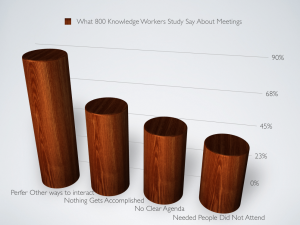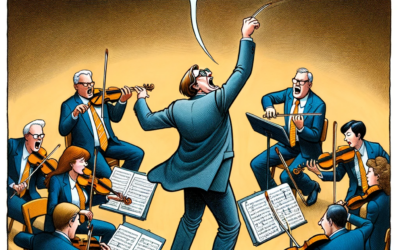 Are your meetings worth the cost?
Are your meetings worth the cost?
On average, there are 17 million meetings a day in the United States, and most professionals spend 61.8 hours per month in meetings.
The amount of time we spend in meetings is staggering, and so is the cost. According to Infocom, a five-person meeting typically costs $5,197 when all participants travel. That cost soars even higher when you factor in the cost of people’s time. Collectively these five people will take over 53 hours and 24 minutes to prepare for, travel to, and attend one meeting.
The US Bureau of Labor Statistics estimated the annual loss to business from unnecessary meetings at $37 billion. How much of this $37 billion belongs to you and your organization?
If you really want the answer, take your own salary on an hourly basis (Annual Salary / 2000 hours) and multiply it by the number of hours you spend each year in meetings (weekly average X the number of weeks you work per year). Now do this calculation for everyone in your department and organization.
The cost of meetings adds up.
Given how much time and money meetings cost, you might assume that we’ve perfected how to conduct meetings. Sadly, that’s not the case. Rarely are leaders trained how to organize, run, or effectively participate in meetings. As a result, they and their team members grow frustrated. In a recent study of over 800 knowledge workers, 9 out of 10 said that they prefer to interact in any other way than meetings. They dislike the fact that in meetings nothing gets accomplished (60%), there is no clear agenda (50%), and that key people did not attend (42%).
Four ways to reduce the cost and increase the effectiveness of meetings
As a leader, you understand that attention spans have shrunk (or weren’t as long as we once thought), but have you adjusted your meetings agendas to maximize attention and productivity? Attention levels are high (91%) in short 15-minute meetings, but drop precipitously to 64% for meetings exceeding 45 minutes. Think about the implications of these statistics and the multiplying costs to your organization.
Then factor in the drop of engagement because the presenter does 78% of the talking rather than engaging participants with questions and moving the group into conversation. Our school system has provided a model of deference for the teacher that has been transported into our working life and how we meet when in groups and teams. To conduct effective meetings, however, means that you can not continue to emulate your childhood model any longer.
Here are four things you can do to reduce the costs–both financial and psychological–of meetings and increase their effectiveness:
1. Shorten your meetings. They don’t have to last an hour or even half an hour.
2. Cut down and clarify the agenda. What is the goal, and what type of meeting will it be?
3. Make sure the key people will attend. If they can’t, reschedule the meeting.
4. Include an interactive component. Don’t just lecture. Engage participants with prepared questions or polls or small-group work, so they will leave feeling energized and part of the process.




